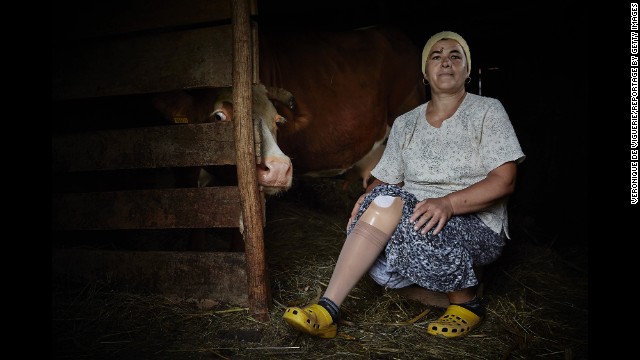 Zilka Durmisevic was injured by a land mine in 1999 while she was cleaning her parents' house in the Bosnian village of Kamenica. Her leg had to be amputated below the knee. Land mines remain a threat in many areas around the world that were once war zones.
Zilka Durmisevic was injured by a land mine in 1999 while she was cleaning her parents' house in the Bosnian village of Kamenica. Her leg had to be amputated below the knee. Land mines remain a threat in many areas around the world that were once war zones.  Photojournalist Veronique de Viguerie recently documented the effects of land mines in Bosnia-Herzegovina. She was one of five photographers commissioned by the International Committee of the Red Cross in partnership with Getty Images.
Photojournalist Veronique de Viguerie recently documented the effects of land mines in Bosnia-Herzegovina. She was one of five photographers commissioned by the International Committee of the Red Cross in partnership with Getty Images.  Land mine victims take part in a sitting volley ball match at the Doboj Gym Hall in Zenica, Bosnia.
Land mine victims take part in a sitting volley ball match at the Doboj Gym Hall in Zenica, Bosnia.  A deminer from Norwegian People's Aid, a humanitarian organization, uses a dog to locate mines in Grebnice, Bosnia.
A deminer from Norwegian People's Aid, a humanitarian organization, uses a dog to locate mines in Grebnice, Bosnia. 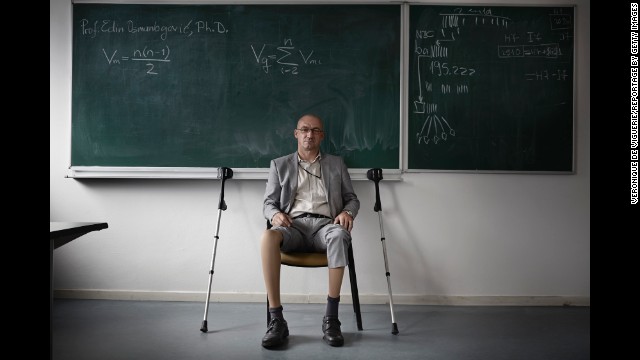 Edin Osmanbegovic had both his legs amputated in 1992 after he stepped on a land mine in Bosnia. He now teaches economics at the University of Tuzla. "Any effort you make will be rewarded," he said. "Anything you learn in life will be enriching. Never give up."
Edin Osmanbegovic had both his legs amputated in 1992 after he stepped on a land mine in Bosnia. He now teaches economics at the University of Tuzla. "Any effort you make will be rewarded," he said. "Anything you learn in life will be enriching. Never give up."  Veterans from both sides of the Bosnian War can be found at the Doboj Gym Hall in Zenica. The team sports are seen as an important part of the reconciliation process.
Veterans from both sides of the Bosnian War can be found at the Doboj Gym Hall in Zenica. The team sports are seen as an important part of the reconciliation process. 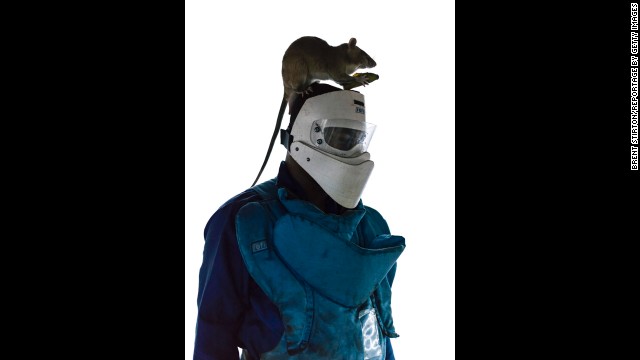 Photographer Brent Stirton was sent to cover the situation in Mozambique, one of the most heavily land mine-ridden countries in the world. The APOPO demining company has used African pouched rats to detect land mines in the country since 2003.
Photographer Brent Stirton was sent to cover the situation in Mozambique, one of the most heavily land mine-ridden countries in the world. The APOPO demining company has used African pouched rats to detect land mines in the country since 2003.  The HALO Trust demining camp is seen in the Chinsunga mountains in Mozambique's Tete province. The organization has cleared more than 22,700 anti-personnel mines and reclaimed more than 500,000 square meters of land for the local population. Mozambique is pushing to be land mine-free by the end of 2014.
The HALO Trust demining camp is seen in the Chinsunga mountains in Mozambique's Tete province. The organization has cleared more than 22,700 anti-personnel mines and reclaimed more than 500,000 square meters of land for the local population. Mozambique is pushing to be land mine-free by the end of 2014. 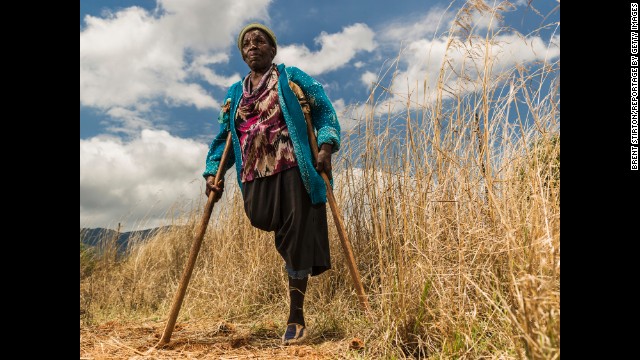 Requina Jimu lost her leg in 1987 to a land mine laid by Rhodesian forces at the Mozambique-Zimbabwe border in the 1970s. Her husband was killed by a land mine a year later. "Everything changed when I lost my leg," she said. "Now I am a beggar."
Requina Jimu lost her leg in 1987 to a land mine laid by Rhodesian forces at the Mozambique-Zimbabwe border in the 1970s. Her husband was killed by a land mine a year later. "Everything changed when I lost my leg," she said. "Now I am a beggar."  Matteo Muxambo lost his foot in 1995. He was walking along a trail near the Mozambique-Zimbabwe border when he stepped off the path to allow a woman to pass. He was blown back by an anti-personnel mine, which took off his foot and severely injured the passing woman.
Matteo Muxambo lost his foot in 1995. He was walking along a trail near the Mozambique-Zimbabwe border when he stepped off the path to allow a woman to pass. He was blown back by an anti-personnel mine, which took off his foot and severely injured the passing woman.  Former Mozambique Liberation Front soldiers are seen at their squatter housing in an abandoned building. Most of them are disabled as a result of land mine blasts. They receive a small pension every month from the government.
Former Mozambique Liberation Front soldiers are seen at their squatter housing in an abandoned building. Most of them are disabled as a result of land mine blasts. They receive a small pension every month from the government. 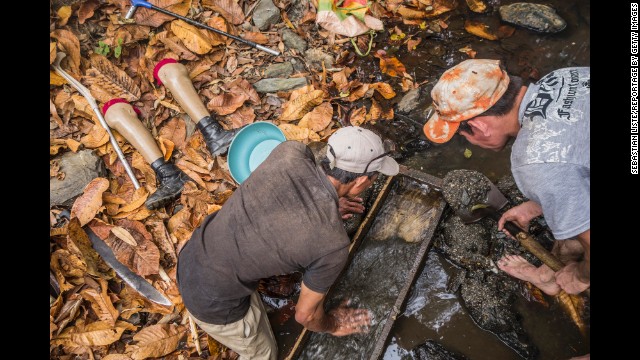 Sebastian Liste, a Spanish photographer based in Brazil, says he was impressed by the resilience of the land mine victims he met in Nicaragua. Juan Ramón López started his own gold mining business after losing both his legs.
Sebastian Liste, a Spanish photographer based in Brazil, says he was impressed by the resilience of the land mine victims he met in Nicaragua. Juan Ramón López started his own gold mining business after losing both his legs.  Carlos José García Agurto was injured in 1985 by an anti-personnel mine near the Honduras-Nicaragua border. After the accident, he went to law school and now works as a lawyer.
Carlos José García Agurto was injured in 1985 by an anti-personnel mine near the Honduras-Nicaragua border. After the accident, he went to law school and now works as a lawyer.  Shelves hold prosthetics at the Aldo Chavarria Hospital in Managua, Nicaragua.
Shelves hold prosthetics at the Aldo Chavarria Hospital in Managua, Nicaragua. 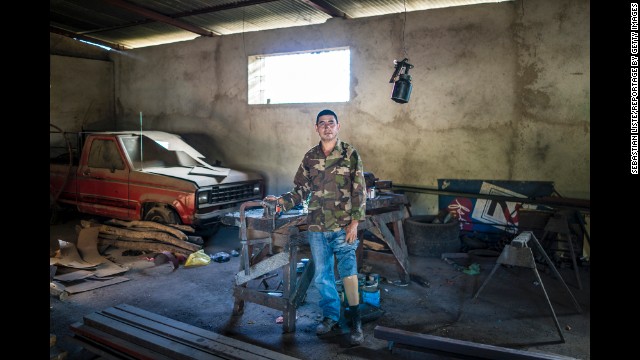 José Luís López Casas lost his left leg to a land mine near the Nicaragua-Honduras border in 1987. Now he works as an industrial mechanic.
José Luís López Casas lost his left leg to a land mine near the Nicaragua-Honduras border in 1987. Now he works as an industrial mechanic. 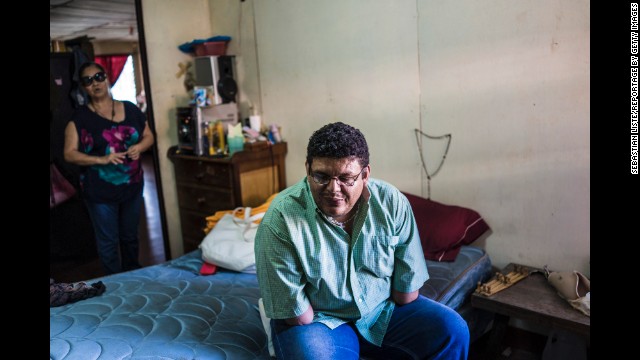 Milton Ivan Olivar Gómez was injured in 1984 by an anti-personnel mine in the Rio Pire near Condega, Nicaragua. He lost both his hands and had damage to his eyes and ears. Since the accident, he has studied and worked in a printing office and as a radio journalist.
Milton Ivan Olivar Gómez was injured in 1984 by an anti-personnel mine in the Rio Pire near Condega, Nicaragua. He lost both his hands and had damage to his eyes and ears. Since the accident, he has studied and worked in a printing office and as a radio journalist. 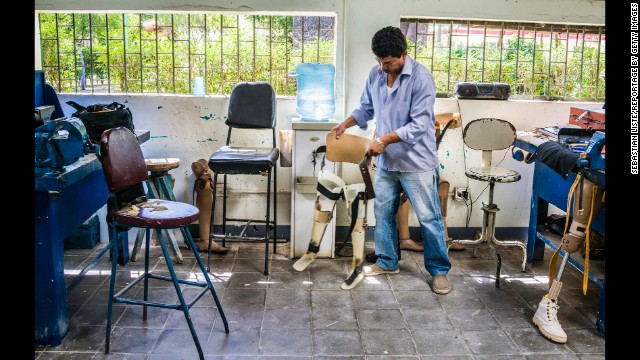 A technician works in the rehabilitation center at the Aldo Chavarria Hospital in Managua.
A technician works in the rehabilitation center at the Aldo Chavarria Hospital in Managua.  A deminer from Iraqi Kurdistan Mine Action Agency practices next to a mine field in the Iraqi village of Mawilian. The mines were placed by the Iraqi Army during the Iraq-Iran war in the 1980s. Marco di Lauro, who photographed the Iraq War in 2003, returned in 2014 to document the country's struggles with landmines.
A deminer from Iraqi Kurdistan Mine Action Agency practices next to a mine field in the Iraqi village of Mawilian. The mines were placed by the Iraqi Army during the Iraq-Iran war in the 1980s. Marco di Lauro, who photographed the Iraq War in 2003, returned in 2014 to document the country's struggles with landmines.  Bassim Miftin was working as a shepherd in 2004 when he stepped on a land mine in the Iraqi village of Zorbatya. He lost his left leg above the knee and injured his right foot.
Bassim Miftin was working as a shepherd in 2004 when he stepped on a land mine in the Iraqi village of Zorbatya. He lost his left leg above the knee and injured his right foot.  Prosthetic feet are stored at the ICRC's physical rehabilitation center in Najaf, Iraq.
Prosthetic feet are stored at the ICRC's physical rehabilitation center in Najaf, Iraq.  A technician manufactures prosthetics at the rehabilitation center in Najaf.
A technician manufactures prosthetics at the rehabilitation center in Najaf.  Auob Omar Hammadamin lost his right hand during the Iraq-Iran war in 1981. He was 11 and playing with his friends in the street when a land mine exploded, killing a young girl.
Auob Omar Hammadamin lost his right hand during the Iraq-Iran war in 1981. He was 11 and playing with his friends in the street when a land mine exploded, killing a young girl. 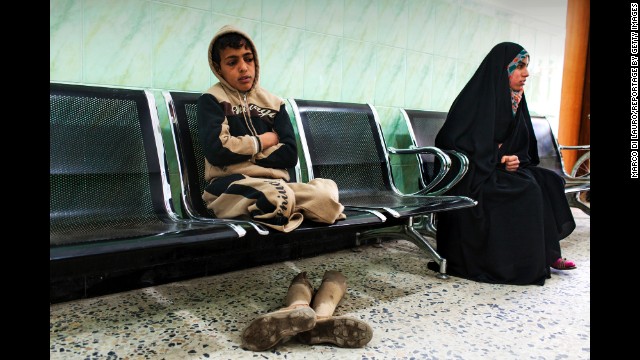 Sajad Faleh, 12, waits for his assessment at the rehabilitation center in Najaf. He lost both his legs to a land mine in 2006. He also lost two of his brothers in the blast.
Sajad Faleh, 12, waits for his assessment at the rehabilitation center in Najaf. He lost both his legs to a land mine in 2006. He also lost two of his brothers in the blast.  One of the land mine victims photographer Paula Bronstein met in Laos was a 10-year-old named Aiyaok. He is seen here playing soccer with other children in the village of Tamluang.
One of the land mine victims photographer Paula Bronstein met in Laos was a 10-year-old named Aiyaok. He is seen here playing soccer with other children in the village of Tamluang. 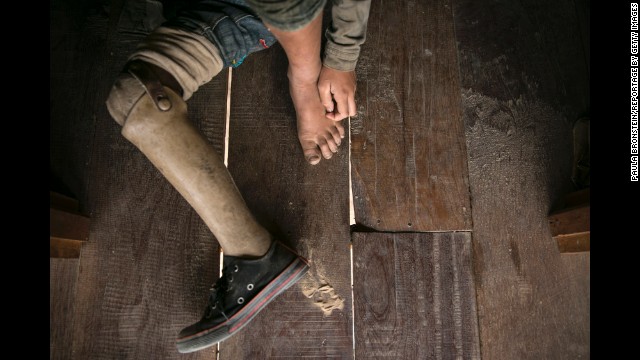 Aiyaok lost his leg in 2012. Families were gathered around a fire to keep warm when a bomb buried underground exploded, killing four people.
Aiyaok lost his leg in 2012. Families were gathered around a fire to keep warm when a bomb buried underground exploded, killing four people.  Another victim in Laos lost his hand and was blinded by a land mine he found while farming more than three decades ago. He picked it up, and it went off.
Another victim in Laos lost his hand and was blinded by a land mine he found while farming more than three decades ago. He picked it up, and it went off. 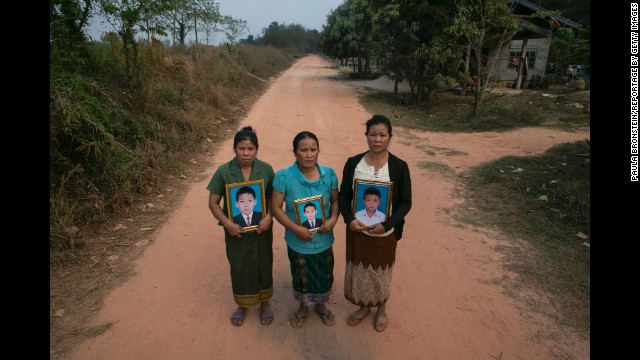 Three mothers hold framed portraits of their sons on the same dirt road in Laos where they were killed in January. The children found a cluster bomb and started playing with it like it was a toy.
Three mothers hold framed portraits of their sons on the same dirt road in Laos where they were killed in January. The children found a cluster bomb and started playing with it like it was a toy. 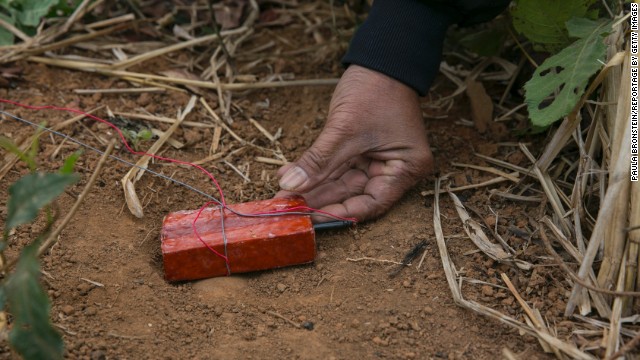 A member of the UXO Lao clearance team gets ready to detonate munitions found after a day of work in the Lateuang village. The government-run organization has been clearing land mines in Laos since 1996.
A member of the UXO Lao clearance team gets ready to detonate munitions found after a day of work in the Lateuang village. The government-run organization has been clearing land mines in Laos since 1996.
- Land mines remain a threat in areas that were once war zones
- Photographers documented the issue across five countries
- Victims have received little real support, one photographer says
(CNN) -- She stands tall, two makeshift wooden crutches propping up her one-legged body in the same fields that took so much from her. She stares into the sun with a stern face, hardened by years of loss.
Over the past 28 years, Requina Jimu lost her leg, a year later: her husband, and over the years to come: 11 of her 13 children. All innocent victims of land mines laid by Rhodesian forces in Mozambique in the 1970s.
They're located worldwide, in backyards, in fields, incognito. Dubbed the "perfect little soldiers" by Khmer Rouge dictator Pol Pot, land mines are silent, usually obscured and always destructive.
Explosive devices have been used in combat for centuries to maim or completely obliterate an enemy. But long after the battles are done, when the peace treaty is signed, these destructive detonators don't retreat with the troops.
They stay -- haunting the lands, harming innocent civilians who happen upon them. Programmed only to respond to pressure, these weapons continue to fracture bones, limbs and lives across various war-torn regions on a daily basis.
Photos: Heroes and survivors in the war on land mines
"Land mines are so often a forgotten theme which continue to affect millions," photographer Brent Stirton said. Stirton was commission by the International Committee of the Red Cross in partnership with Getty Images to document the human effects of landmines in Mozambique, one of the most heavily land mine-ridden countries in the world.
His camera captured victims' various missing body parts, antique prosthetics and the brave men who mine the fields removing the explosives that were placed there over four decades ago and continue to affect some 50% of arable land in the region.
It's outrageous after so many years, children are still victims of this war which happened 20 years ago.
Veronique de Viguerie, photographer
Mozambique set a goal to be land mine-free by the end of 2014. But while the deminers are working feverishly to clear the fields, Stirton said the victims have received little real support.
"Nearly 40 years after the conflict, and impoverished communities still don't have access to valuable farming land," he said. "Land mines can certainly be an economic issue."
Mozambique is hosting an international conference to implement the Mine Ban Treaty from June 23 to 27, which aims to end the use, production, stockpiling and transferring of antipersonnel mines. Countries with strong militaries, namely the United States, China and Russia, have yet to sign on.
In the lead up to the conference, ICRC and Getty sent additional photographers to four other countries still plagued by explosives: Laos, Bosnia-Herzegovina, Iraq and Nicaragua. Their work highlights the ongoing problem of land mines and supports efforts to eradicate these camouflaged foes through powerful images.
Veronique de Viguerie's portraits of victims in Bosnia were framed very deliberately to showcase the humanity in the pictures, "only with a second look the injury should be noticed," she said.
Like Stirton, Viguerie was also surprised to see that land mines are still a daily worry.
"It's outrageous after so many years, children are still victims of this war which happened 20 years ago, and they are paying the highest price with their life," she said.
Paula Bronstein, a photographer based in Southeast Asia, traveled to Laos, where she noted the lack of education regarding munitions.
One of her most poignant images displays three mothers holding framed portraits of their sons on the same dirt road where the blast killed them. They had found a cluster bomb and started playing with it like it was a toy, not knowing its destructive nature.
"I have a real sympathy for these people, because they're really forgotten," Bronstein said of the victims, "and it's still happening, all the time."
Marco di Lauro, who photographed the war in Iraq at its peak, said that returning in 2014 to shoot the land mine project was one of the most emotionally difficult jobs he's done.
In a video interview with Reportage by Getty Images, he said on the nights he couldn't sleep after the assignment, he saw the face of a double amputee boy he photographed, who not only lost both of his legs but also two of his brothers -- all because of what he called "the worst weapons we have ever invented as human beings."
Photographer Sebastian Liste went to Nicaragua, where he was thoroughly impressed by the mine victims as they continued to lead normal lives -- working in the fields or coffee plantations, or mining for gold.
He noted in an interview with Reportage by Getty Images that the prosthetics were a very important part of their lives. One victim, Juan Ramón López, started his own gold mining business after losing both legs. He would run through the forest to the river and spent all day mining for gold to support his large family, Liste recalled. That was something he could not do without the prosthetics.
"It really makes you reflect about your own life," Liste said. "You're always complaining about these things or these things, but when you meet these people you're like, 'OK I have two hands, I have two legs, stop complaining.' "
CNN's Brett Roegiers contributed to this report.
No comments:
Post a Comment